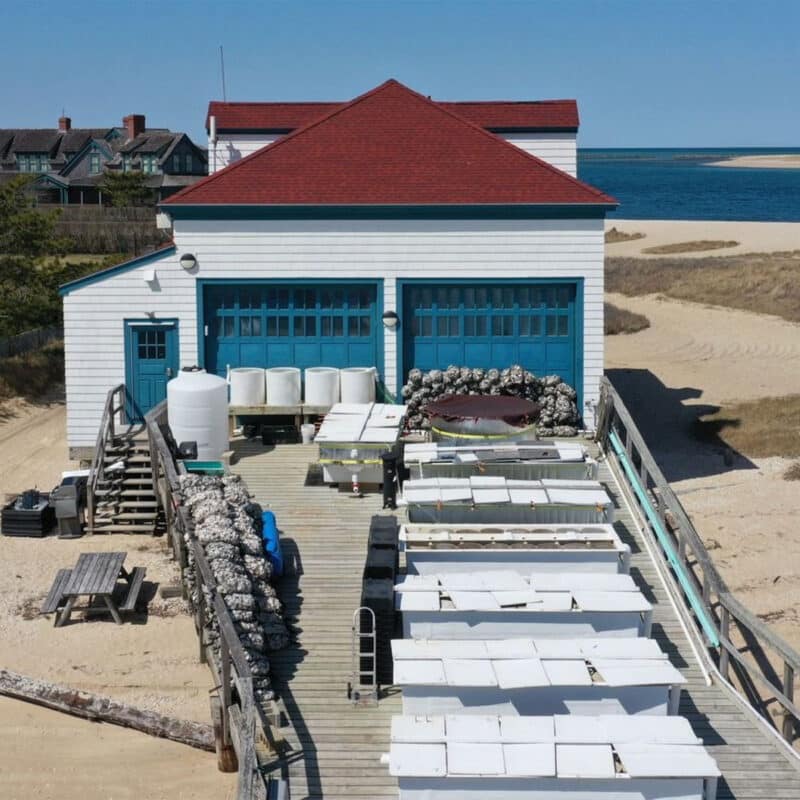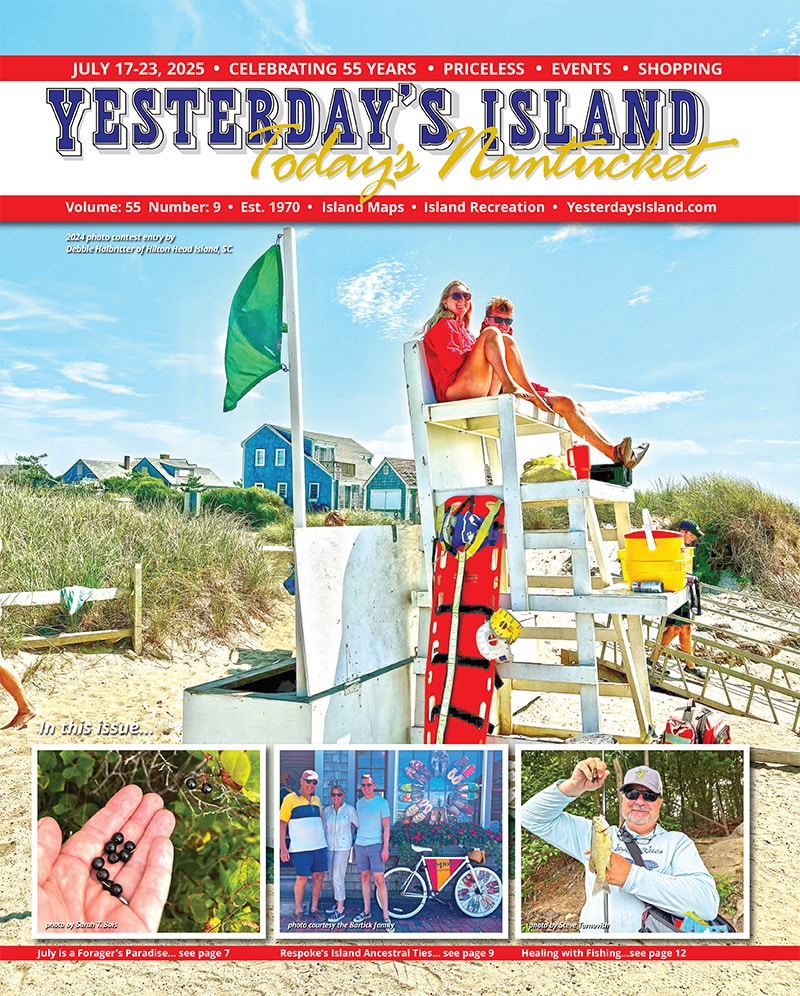by C. Oscar Olson
It’s fun to wonder what Nantucket might have looked like before the arrival of the Wampanoags, during the booming whaling days, and the explosion of tourism today. The landscape must have been so very different.
Thick scrub oak forests, rolling meadows, and seagrass lining every shore paints a picture of an incredibly healthy, thriving, and balanced ecosystem. There is no doubt that a lot has changed in a few hundred years, and we’re lucky that there are people working to bring some of that balance back from the brink.
The ocean and all of its endless glory is what draws most people here. But it’s the beaches and waters that surround us, especially the harbor, that have seen the most change. A century of pollution, fertilizer runoff, and a bounty of other blights have changed the nature of the sea and specifically the creatures that live there. Due to these factors and more, their numbers have declined dramatically, and the health of our harbor is waning as a result.
Shellfish once thrived in abundance in our coastal waters. They were not only delicious and a rich source of protein, vitamins, and minerals, but they helped to clean their habitat and provide shelter and spaces to for others to grow. Defined as filter feeders, animals like clams, oysters, and scallops remove particles and impurities from the ocean while they eat.
Thankfully, groups like the Brant Point Shellfish Hatchery are doing their part to help. A facility operated by the town of Nantucket, the staff specializes in the production of Nantucket bay scallops to supplement the wild population in Nantucket and Madaket Harbors. Shellfish Biologist Tara Riley heads the operation.
Located next to Brant Point Lighthouse, the small, unassuming boathouse is where the magic happens. Tara and her team work to restore both the bay scallop commercial and recreational fisheries, in addition to oysters, quahogs, water quality, and more. “Anything that has to with the harbor, we’re involved,” she says.
Tara was drawn to this line of work after just one class in college. “I was fascinated with the field of aquaculture and fisheries from my first exposure to a class I took in college,” she recalls, “farming aquatic species for stock enhancement, sustainability, and an additional protein source just made sense to me.”
She grew up down south in the suburbs of Atlanta and has always felt a pull to more spread out coastal communities. She stumbled upon an ad posted by the Town of Nantucket for a biologist position, and she jumped on it. “The day that I interviewed was my first time visiting Nantucket and I instantly fell in love with the ‘boathouse’ on Brant Point, and the idea of creating a municipal hatchery to help with the bay scallop fishery and other natural resource initiatives for Nantucket. Luckily, the town agreed that I was a good fit for the position. Two months later, I was selling my house and moving up to Nantucket.”
All the conditions in the building are made to mimic spring conditions on-island. From the air temperature to the water, even timed lights set to be on for 16 hours a day. These are the ideal conditions for encouraging the spawning and growth of shellfish. The Hatchery even grows their own algae.
“The biggest part about operating a hatchery is growing enough food, because they eat a lot.” Tara helps grow several different species of algae, each with their own unique nutritional benefit to the burgeoning bivalves. “Every species has a different nutritional profile,” she explained, “some are higher in starches and lipids; some are more rich in vitamins.”
Brant Point is an ideal location for a hatchery. When the tide comes in, fresh, clean water is pumped into the boathouse to keep the shellfish clean, healthy, and happy. After growing and going through a series of tanks, the shellfish are released into the harbor.
Once the shellfish are set free, the hatchery team takes care to monitor their development. They make use of many techniques. One method is utilizing spat lines. “These bags contain a material that larval scallops will attach to in their 12-14th day of life,” explained Tara, “they help us to determine when the natural spawns in the harbor are occurring and which area any given spawn may have recruited.”
The hatchery staff also performs routine dive surveys. According to Tara, “These allow us to zero-in on scallop populations (they can swim and shift around based on wind and current patterns). Once we have located the populations, we are able to map the area and create an evaluation plan that involves an underwater survey of collecting data on scallop abundance and classification, habitat characteristics, and water quality.”
The hatchery is currently keep an eye on a 2021 release of larvae in Madaket Harbor. “We are monitoring the size, health, predation, density, and overall survival during the summer months.” The hatchery also relies on local scallopers, fisherman, and other community members. “They help to notify us if there is a seed population that we missed, whether it is in the harbor or stranded on the beach or shallows,” said Tara. “During the winter, the Nantucket Shellfish Association coordinated several fishermen to thin out the seed bed in Madaket to help with growth and survival. They were able to move over 1000 bushels, which was so amazing!”
Tara and her team have been working towards and improving monitoring and stock enhancement techniques since 2010. “The fishery overall has been in decline since its peak in the mid 80s. In the past 10 years, we have harvested a high of 20,000 bushels and a low of 3,500 bushels.” Their efforts, combined with local and state laws applying less pressure on the stock, is starting to help. “Fishermen just aren’t as actively engaged in the fishery on a regular basis due to the unpredictable harvests each season.”
The biggest hurdle is the quality of the water in our harbor. “Water quality pressures triggered by rapid growth and development are the ultimate roadblock for our fishery and the eelgrass rebounding. Without the water quality at a certain level, our waters cannot sustain restoration efforts successfully.
“We are working harder than ever to understand each new challenge that our natural resources are presented with. It is a big job with many variables and different opinions. Overall, our department remains optimistic that although progress can seem slow, we are working towards positive changes that will ultimately improve our water quality and in tandem allow the scallops and eelgrass to be restored.”
With a venture of this magnitude, patience is a must. “It will likely take 5 to 10 years to see any noticeable change,” commented Tara.
We can’t wait to see what the future hold for the harbor. For more information on Nantucket’s Brant Point Shellfish Hatchery and to schedule a tour, go to nantucket-ma.gov/691/Brant-Point-Shellfish-Hatchery.



